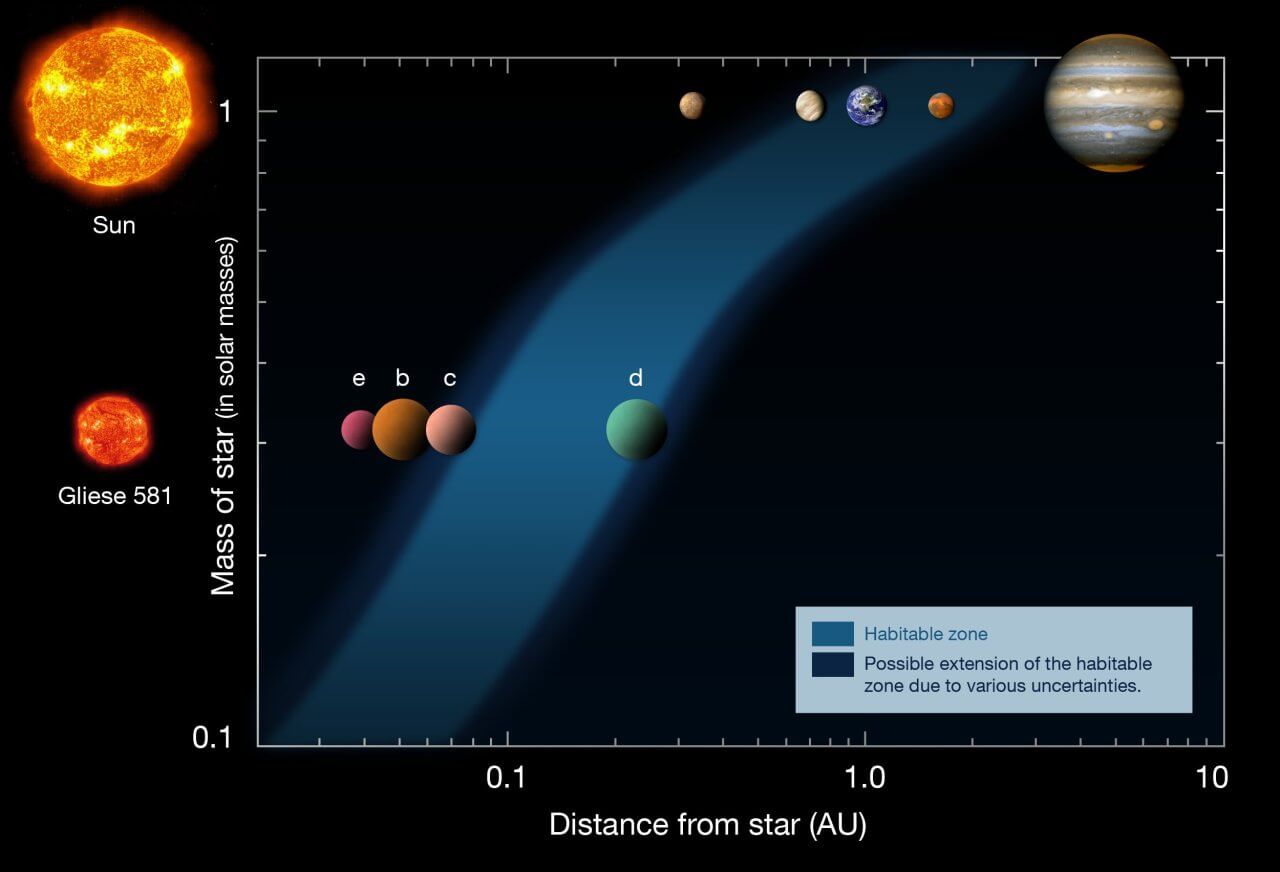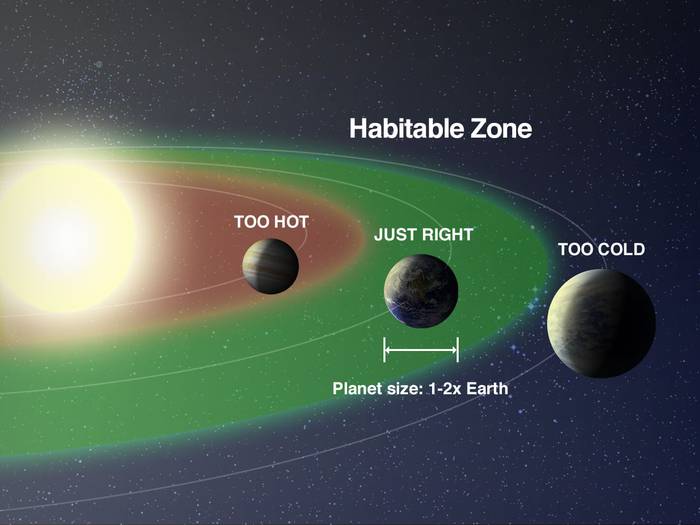Image © NASA
Heretofore, there is only one planet we know of, so far, that is drenched with life - the Earth. Do other planets beyond our solar system, called exoplanets, also host life forms?
Detecting exoplanets around the vast and obscure universe, by all means, is imperative. The trend of discovering new exoplanets with their special properties is being accelerated day by day and researchers are studying them. This has been made all possible by different space and ground-based telescopes like Hubble Space Telescope, Five-hundred-meter Aperture Spherical radio Telescope (FAST), and Atacama Large Millimeter/submillimeter Array (ALMA), etc which are well-equipped with the recent scientific principles and instruments. However, only discovering the new exoplanets does not fulfil our space exploration missions; the scientific community is long been in a race to search for the Earth-like habitable exoplanets, still unresolved. Though some tips are with us that a planet within our solar system - Mars contained water in the past and may contain now too, more confirmations are needed.
It is beyond one's wildest dream in both ways - how can we be alone in such a vast universe full of celestial objects floating around us and also if we are not alone.
To determine if a particular exoplanet accommodate biological life, like on Earth, astronomers first have its habitability test.
The first step of the hunt for habitable exoplanet lie in search of planets about the size of Earth that orbit at just the right distance from their star – in a region termed the habitable zone. A planet that is too near to their star will be extremely hot and too far to star will be extremely cold to hold biological life. For instance, the temperature at Mercury can reach above 420 °C, the temperature at the farthest known planet of our solar system (remember that Pluto has been designated to dwarf planet) - Neptune, can reach up to -201.15 °C. This much of extreme hotness or coldness is not favourable to support biological life, as we know today. Maybe in the future, further exploration will unveil and add to our knowledge.
Now come to the habitable zone (sometimes termed as a life zone, comfort zone, green belt, or Goldilocks zone). The habitable zone is described by the Goldilocks principle or 'Goldilocks effect' and the planet is called Goldilocks planet. Basically, habitable zone is defined to the distance from the star where that distance not-too-hot or not-too-cold and liquid water can exist on a planet’s surface as the liquid water is a key ingredient for the life as we know till. However, in some cases like Jupiter’s moon Europa, being on outside of its Goldilocks zone may still contain forms of water. Astronomer already gained a hinted evidence that Europa hold water.

More concerning on habitable zone, the location of a star’s habitable zone depends predominantly on the radiation it emits that subsequently depends on its mass. Stars more massive than our sun are hotter, and blaze with radiation, so their habitable zones are farther out. Similarly, stars that are smaller and cooler sport tighter belts of habitability than our sun.
That perfect Goldilocks planet within the zone wouldn't necessarily be home to any furry creatures. To determine the habitability of an exoplanet, astronomers also look at other parameters like water, temperature, nutrients, energy, and atmosphere, and for this, astronomers exploit the well-designed space and ground telescopes.
One is NASA’s Kepler mission. The Kepler mission is helping scientists in the quest to find habitable worlds at Goldilocks planets because they orbit where conditions are "just right" for life.
Some extraterrestrial life search missions also search for the presence of carbon on its surface as carbon is an imperative element of the biological life.
"There are a lot of unanswered questions about habitability," said Lucianne Walkowicz, a Kepler science team member based at Princeton University, N.J., who studies flaring stars. "If the planet gets zapped with radiation all the time by flares from its parent star, the surface might not be a very pleasant place to live. But on the other hand, if there's liquid water around, that makes a really good shield from high-energy radiation, so maybe life could thrive in the oceans."
Also, the habitable zone of a star also depends on chemistry like the molecules in a planet's atmosphere that absorb a certain amount of energy from starlight and radiate the rest back out, and how much of this energy is trapped within their atmosphere.
Other general requirements for life are:
-
Not orbit a star that is too close to a cosmic explosion like a supernova
-
Be far enough from massive planets that they do not continually divert asteroids to hit it or perturb its orbit strongly
-
Probably not be so massive that it retains hydrogen and becomes a "gas giant"
-
Perhaps it is also essential to have a massive planet well outside its orbit, like Jupiter, to divert potential devastating asteroids away, or to make them destroy themselves (as in the asteroid belt).
|
Factors that make Planet habitable |
Not enough of the factor |
Just Right |
Too Much of the Factor |
Situation in the Solar System |
|
Temperature |
Low temperatures cause chemicals to react slowly, which interferes with the reactions necessary for life. Also, low temperatures freeze water, making liquid water unavailable. |
Life seems limited to a temperature range of minus 15oC to 115oC. In this range, liquid water can still exist under certain conditions. |
At about 125oC, protein and carbohydrate molecules and genetic material (e.g., DNA and RNA) start to break apart. Also, high temperatures quickly evaporate water |
Surface: Only Earth’s surface is in this temperature range. Sub-surface: The interior of the solid planets & moons may be in this temperature range. |
|
Water |
The chemicals a cell needs for energy & growth are not dissolved or transported to the cell |
Water is regularly available. Life can go dormant between wet periods, but, eventually, water needs to be available. |
Too much water is not a problem, as long as it is not so toxic that it interferes with the chemistry of life |
Surface: Only Earth’s surface has water, though Mars once had surface water and still has water ice in its polar ice caps. Saturn’s moon, Titan, seems to be covered with liquid methane. Sub-surface: Mars & some moons have deposits of underground ice, which might melt to produce water. Europa has a vast ocean beneath its outer shell if ice. |
|
Atmosphere |
Small planets and moons have insufficient gravity to hold an atmosphere. The gas molecules escape to space, leaving the planet or moon without an insulating blanket or a protective shield. |
Earth & Venus are the right size to hold a sufficient-sized atmosphere. Earth’s atmosphere is about 100 miles thick. It keeps the surface warm & protects it from radiation & small- to medium-sized meteorites. |
Venus’s atmosphere is 100 times thicker than Earth’s. It is made almost entirely of greenhouse gasses, making the surface too hot for life. The four giant planets are completely made of gas. |
Of the solid planets & moons, only Earth, Venus, & Titan have significant atmospheres. Mars’ atmosphere is about 1/100th that of Earth’s, too small for significant insulation or shielding. |
|
Energy |
When there is too little sunlight or too few of the chemicals that provide energy to cells, such as iron or sulfur, organisms die. |
With a steady input of either light or chemical energy, cells can run the chemical reactions necessary for life. |
Light energy is a problem if it makes a planet too hot or if there are too many harmful rays, such as ultraviolet. Too many energy-rich chemicals are not a problem. |
Surface: The inner planets get too much sunlight for life. The outer planets get too little. Sub-surface: Most solid planets & moons have energy-rich chemicals. |
|
Nutrients |
Without chemicals to make proteins & carbohydrates, organisms cannot grow. Planets without systems to deliver nutrients to its organisms (e.g., a water cycle or volcanic activity) cannot support life. Also, when nutrients are spread so thin that they are hard to obtain, such as on a gas planet, life cannot exist. |
All solid planets & moons have the same general chemical makeup, so nutrients are present. Those with a water cycle or volcanic activity can transport and replenish the chemicals required by living organisms. |
Too many nutrients are not a problem. However, too active a circulation system, such as the constant volcanism on Jupiter’s moon, Io, or the churning atmospheres of the gas planets, interferes with an organism’s ability to get enough nutrients. |
Surface: Earth has a water cycle, an atmosphere, and volcanoes to circulate nutrients. Venus, Titan, Io, and Mars have nutrients and ways to circulate them to organisms. Sub-surface: Any planet or moon with sub-surface water or molten rock can circulate and replenish nutrients for organisms. |
NASA's upcoming James Webb Space Telescope will bring us closer to this goal, by probing the atmospheres of planets, some of which may lie in habitable zones.
